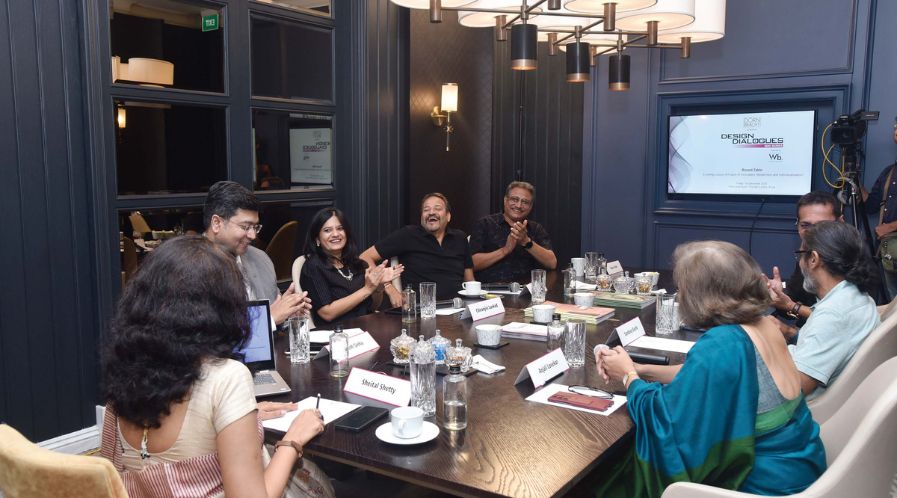Evolving Luxury: A Fusion of Innovation, Modernism and Individualisation?
Panellists discussed how the perception of luxury has changed over time in India and the key defining trends in luxury washroom design
Luxury is a relative term. The perception of luxury varies from person to person. And even more, it could vary over a space of time. Setting the tone of the discussion, Sheital Shetty, Editor & Publisher, Washrooms and Beyond – the moderator of the session remarked, “There are several factors driving the changes in luxury perception for the new age consumers. Nowadays, technology and automation are playing a bigger role in creating a luxury aura for the new age consumers.”

Anil Ranka
Founder & Principal Architect, Anil Ranka Architects
“Luxury goes beyond the physical aspect of it. Wellness products that cater to emotional well-being are a new facet of luxury. Exposure is crucial for understanding and aspiring to own these products. Cultural backgrounds also influence the perception of luxury.”
The Changing Sensibilities of Luxury
She further asked some pertinent questions, “Given that luxury perception varies from project to project, how do you define luxury? And, how do you approach designing a luxurious space?”
Responding to the questions, Rajeev Shah, Principal Designer, Delta asserted that luxury is about conveniences. “For me, luxury is about providing functionalities that reduce the effort that needs to be put in by the user. Any service, product, or design that minimises effort is luxurious. Advancement in technology and automation is redefining the modern-day luxury design.”
Anjali Lovekar, Principal Partner, Lovekar Design Associates opined, “Luxury is an abstract concept. It’s relative to the individual, setting, and socio-economic background. Time itself can be a luxury. Having the space and time to enjoy a well-designed washroom with well-engineered products is itself luxurious.”
Sandeep Bamb, Director, Samyak C2 Infra Pvt. Ltd. highlighted the emotional aspect of luxury. “Luxury is also connected to emotions and creating a unique experience through design and products. Exposure fuels desire, pushing the boundaries of what’s considered luxurious. Brands and users are constantly seeking the ‘next big thing’.”

Anjali Lovekar
Principal Partner, Lovekar Design Associates
“Rapid urbanisation necessitates responsible luxury. We generate a massive amount of waste and resource consumption. Innovation, coupled with artistry and sustainable practices, is the key.”
Anil Ranka, Founder & Principal Architect, Anil Ranka Architects stated that luxury goes beyond the physical aspect of it. “Wellness products that cater to emotional well-being are a new facet of luxury. Exposure is crucial for understanding and aspiring to own these products. Cultural backgrounds also influence the perception of luxury.”
Talking about how the perception of luxury changed through generations, Chiranjivi Lunkad, Partner, Studio Infinity added, “Growing aspirations and exposure is changing what is perceived as luxury. As generations change, so does the definition of luxury. What was considered a luxury for the previous generation may have become a necessity for the current generation. For example, millennials and Gen Z, with constant digital exposure, have different aspirations. Our generation might have gotten our first Apple product in our 30s or 40s, whereas the current generation has it by 16. This alters their perception of necessity and luxury.”
Sunil Patil, Principal Architect, Sunil Patil & Associates talked about the factors behind the changing luxury perceptions in India. “First of all, growing exposure to luxurious products across the world through travel and also through various digital mediums has heightened the aspirations of Indian consumers. Secondly, now majority of the luxury brands are easily available in India and this easy access has led to increased demand for luxury products. Third, the growing purchasing power of the Indian consumers coupled with luxury products becoming somewhat affordable is another facet of changing luxury landscapes in India.”

Chiranjivi Lunkad
Partner, Studio Infinity
“Growing aspirations and exposure is changing what is perceived as luxury. As generations change, so does the definition of luxury. What was considered a luxury for the previous generation may have become a necessity for the current generation.”
Innovations and Modernisation
Bamb predicted that the next phase in luxury will be driven by the integration of technology and automation leading to product innovations that offer conveniences to users. “Innovation that seamlessly integrates technology and automation into user-friendly products will be much sought after. Luxury lies in creating a space that caters to your overall well-being, potentially integrating features like BMI and weight measurement. However, usability is the key. Technology shouldn’t be overly complex and should cater to a broad audience.”
However, Lovekar opined that many of these technological advancements are driven by Westernisation. “For example, the use of dryers in Indian bathrooms is more of a Western concept brought to India. Given the Indian climate and abundance of sunlight, these products have little utility. But clients accustomed to the Western lifestyle may find it convenient and hence, it is included in luxury washrooms.”
Ranka differed, “For certain segments of clients, dryer is not a luxury but a necessity. For certain clients, instead of using it as a bathroom warmer, we have used it as a dryer for towels, garments etc. While it may not be necessary, it adds to the luxury quotient of the space.”
He further added, “While it started as a Western concept, the design of modern apartments often lacks proper sunlight for drying clothes. Dryers have become a necessity due to limitations in drying space, especially in societies with restrictions on outdoor drying. While in bungalows it may not be a challenge, but in high-rise apartments where the terrace is not accessible and the clients are dependent on the small utility area/balcony for drying will sooner or later feel the need for dryers.”
Patil remarked, “These days many people don’t dry clothes directly in the sunlight. Fading and decolouration of textiles is a concern. So, even if people have access to drying facilities, they intentionally use the dryers. So, if we can use technology to dry the clothes out in the washroom, why not?”

Nilesh Sinha
National Sales and Marketing Director, Dornbracht India
“Ongoing projects, at Dornbracht, are exploring ultra-low-flow showerheads in some countries. These use significantly less water (around 6-8 litres per minute) while maintaining a good showering experience.”
Can Luxury Be Responsible?
To state the obvious, individual wellness needs clearly compete with the growing need to conserve water. Showers and bathtubs are indispensable parts of luxurious washrooms and are prone to high amounts of water consumption to offer wellness and rejuvenation.
“While designers, plumbing consultants and even the manufacturers advocate practising a responsible luxury approach, consumer acceptance has proven to be a hurdle. High-end consumers are mindful about the experience being compromised, to some extent, for implementing water-saving measures,” pointed out Shetty.
According to Patil, sustainability should be at the forefront of washroom innovation. “Sanitaryware and bath fittings should address the sustainability aspect. As responsible designers, we should use more fittings that address the need for water conservation. Innovative use of air to reduce water consumption should be explored – especially in showers.”
Stressing the need to balance out the two, Ranka commented, “Water-saving showerheads are a critical innovation for sustainable bathroom design. Rain showers, while luxurious, can be wasteful. We need to find a balance between a luxurious showering experience and environmental responsibility.”

Rajeev Shah
Principal Designer, Delta
“For me, luxury is about providing functionalities that reduce the effort that needs to be put in by the user. Any service, product, or design that minimises effort is luxurious. Advancement in technology and automation is redefining the modern-day luxury design.”
Throwing some light on the ongoing efforts put in by Dornbracht to reduce the water consumption in luxury showerheads, Nilesh Sinha, National Sales and Marketing Director, Dornbracht India informed, “Ongoing projects are exploring ultra-low-flow showerheads in some countries. These use significantly less water (around 6-8 litres per minute) while maintaining a good showering experience. While 8 litres per minute might seem too low for India initially, it’s a step in the right direction. Rain showers that use about 12 litres of water per minute are already available with us. Encouraging wider adoption of these technologies can significantly reduce water consumption.”
Lunkad highlighted the rising acceptance of water-saving technologies and emphasised the need for affordability to make them accessible to a wider audience.
Loveker concurred, “Rapid urbanisation necessitates responsible luxury. We generate a massive amount of waste and resource consumption. Innovation, coupled with artistry and sustainable practices, is the key.”

Sandeep Bamb
Director, Samyak C2 Infra Pvt. Ltd.
“Luxury is also connected to emotions and creating a unique experience through design and products. Exposure fuels desire, pushing the boundaries of what’s considered luxurious. Brands and users are constantly seeking the ‘next big thing’.”
Is Luxury Mandatorily Expensive?
The panellists were of the opinion that luxury doesn’t need to be necessarily expensive. “The key lies in innovation that is both sustainable and affordable. We need a segment of the market dedicated to ‘affordable luxury’ that makes water-saving technologies accessible to the masses. This will not only benefit individual households but also contribute to a larger environmental impact,” opined Lunkad.
Lovekar added, “Thinking beyond private residences, consider public restrooms in Japan and Germany. These facilities incorporate automation and advanced features while remaining surprisingly affordable. Public restrooms in India could benefit tremendously from similar innovations, not just for the sake of luxury but for hygiene and improved sanitation.”
Talking about where the affordability of innovative solutions could make a difference, Patil opined, “Public restrooms are a prime area where innovation can make a significant difference. Implementing mandatory automated flushing systems and focusing on advancements in public sanitation would be a major step forward. Luxury features can be incorporated for high-end private residences, but for public spaces, functionality, hygiene, and sustainability should be the top priorities.”

Sheital Shetty
Editor & Publisher, Washrooms and Beyond
“To state the obvious, individual wellness needs clearly compete with the growing need to conserve water. Showers and bathtubs are indispensable parts of luxurious washrooms and are prone to high amounts of water consumption to offer wellness and rejuvenation.”
The Future of Luxurious Washrooms
Talking about the future of luxury washroom design, Lovekar proclaimed, “The future lies in a human-centric approach. Bathrooms should be designed to improve our well-being and cater to individual preferences. Sustainable practices and resource management should be seamlessly integrated without compromising on aesthetics or functionality. Individualisation of bathroom design and shower settings is a key trend.”
According to Shah, timeless design principles will continue to be important. “Bathrooms should be a space of comfort and tranquillity, fostering a sense of well-being that transcends trends. Incorporating the latest advancements should be done thoughtfully, ensuring they enhance the user experience rather than becoming a burden.”
Technology is poised to play a major role with even greater personalisation and wellness features. “Voice automation and smart bathroom will enrich the user experiences for digitally savvy consumers,” added Lunkad.

Sunil Patil
Principal Architect, Sunil Patil & Associates
“Sanitaryware and bath fittings should address the sustainability aspect. As responsible designers, we should use more fittings that address the need for water conservation. Innovative use of air to reduce water consumption should be explored – especially in showers.”
Patil remarked that given the hectic lifestyle, there is a growing requirement for compartmentalisation of space within a luxury washroom. “With space becoming a constraint in apartments, designing separate cubicles for the bath, WC and basin area makes sense as it can be used by multiple people simultaneously. On this front, personalisation and individualisation will play a big role.”
Bamb envisioned the ideal washrooms of the future to be smart. “The bathroom of the future will be an intelligent space. It will anticipate our needs, promote wellness, and seamlessly integrate with our lifestyles. But most importantly, it will be a space that fosters a sense of comfort, rejuvenation, and personal luxury.”
[Edited excerpts from a Round Table discussion held on December 1, 2023, at The Ritz-Carlton, Pune as part of Dornbracht presents Design Dialogues – Mini Series powered by Washrooms and Beyond.]
Tags: Anil Ranka, Anjali Lovekar, Chiranjivi Lunkad, Design Dialogues, Dornbracht, Nilesh Sinha, Rajeev Shah, Sandeep Bamb, Sheital Shetty, Sunil Patil



